How to Write SEO Content that Ranks on Google
Topic: SEO
Published:
Written by: Brandon Leuangpaseuth
Do you want to know how to write search engine optimization (SEO) content that ranks on Google? Well, don't worry - it's not as hard as you think.
We'll go over what SEO content is, the benefits of writing it, and the 5 steps you need to know to create optimized content that Google loves.
No more spending hours writing content for your website only to see it buried on page 10 of the search results.
By the end, you'll be a pro at creating SEO content that not only ranks well but also brings in loads of traffic to your website.
So what are you waiting for?
Let's dive into how to develop amazing SEO content.
Note: Clearscope is our product. We’re proud of what we’ve built and believe we have the best content optimization and monitoring platform on the market. Request a personalized demo.
What is SEO content?
SEO content is content designed to rank on search engines. This is accomplished by researching relevant keywords and creating optimized, high-quality content that answers the user's search intent. The type of content could be blog posts, landing pages, interactive tools, products, infographics, or whatever.
Here are the ways SEO content is different than just any ordinary content:
Solves a problem or search intent for a target keyword.
It involves a series of complex instructions and best practices that need to be followed for optimal search engine results.
It is usually more detailed (and sometimes longer) than general content, which provides more value to the reader.
What are the benefits of writing SEO content?
SEO writing is a mix of writing for search algorithms and humans.
Search engines are still algorithms. They are a collection of formulas that analyze large amounts of data to determine the relevance and quality of a particular web page to a user's query.
If we know the search engines or Google’s ranking factors, we can optimize for them. We'd be able to influence the algorithm to favor our content on the search engine results page (SERP).
The writer must use keywords related to the topic naturally while being helpful and satisfying the searcher’s intent.
SEO writing is developing human-friendly content optimized for those ranking factors. If the content needs to be optimized, it could be stuck on several pages beneath the first page of the search engines.
Here are the benefits of SEO writing:
Higher search engine rankings and better brand visibility
Attract more customers through organic search
Build more trust and touch points with your audience
Targets all stages of the conversion funnel
Steps for SEO content writing you need to know
We'll go over, step-by-step, how to create an optimized SEO content piece in the eyes of Google. We'll talk about how to brainstorm topics, do keyword research, analyze search intent, structure your piece, and get your content to stand out above your competitors.
Step 1: Brainstorm topics
Before you begin keyword research, brainstorm some topics to write about. Generate a list of subjects that your customers may care to learn about.
Tools that can help with this are:
Clearscope
Google News
Quora & Reddit
Answer The Public
We’ll show you a few ways to generate topic ideas.
With Clearscope's Topic Exploration Tool, you can create a list of questions and topics to build content around. Simply type in the main keyword and get a list of ideas to build content around.
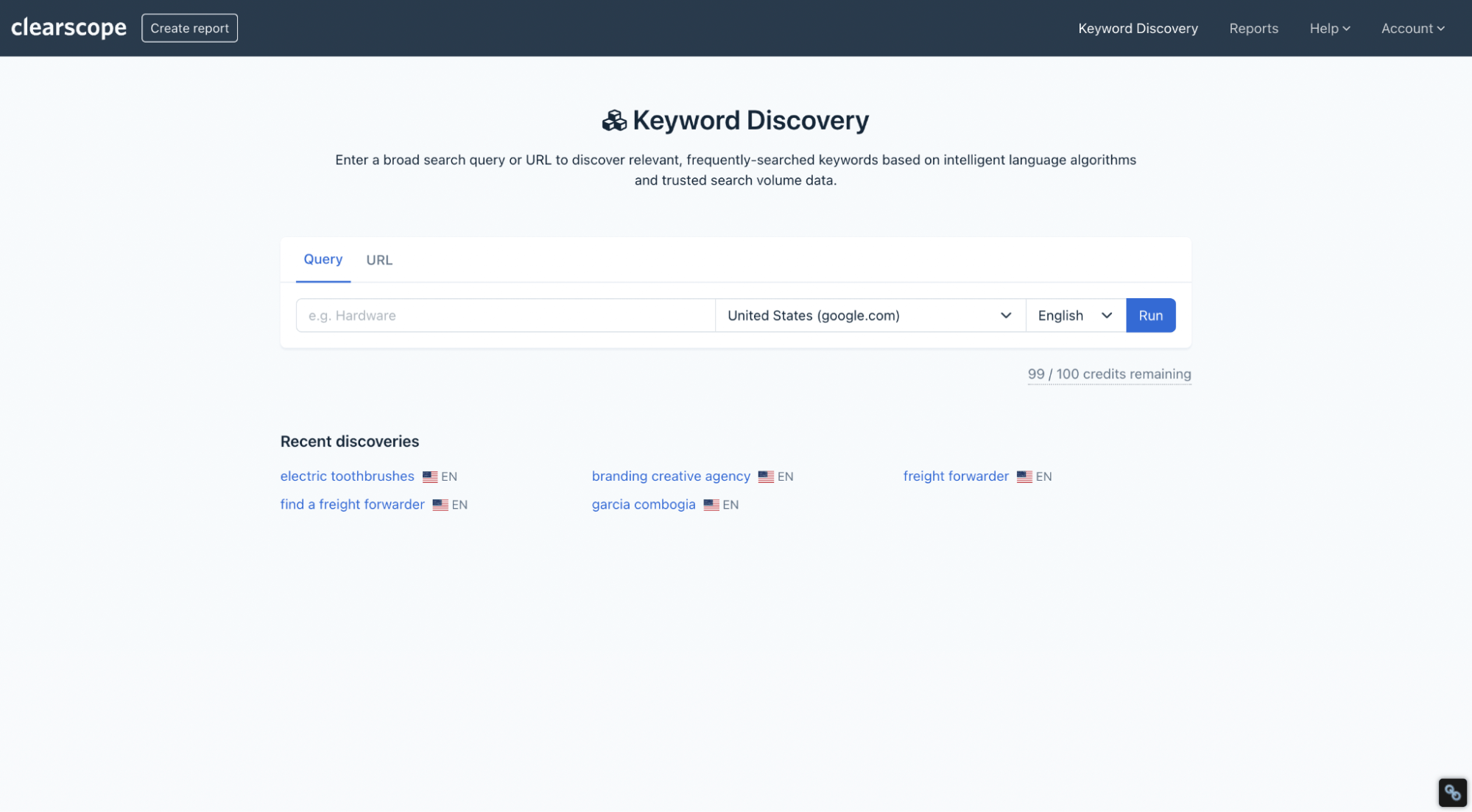
Our Topic Exploration tool.
Here’s an example of questions surrounding the keyword “noise reduction headphones.” You’ll get different questions and relevant info like:
Average monthly searches
Competition
Cost-per-click value.
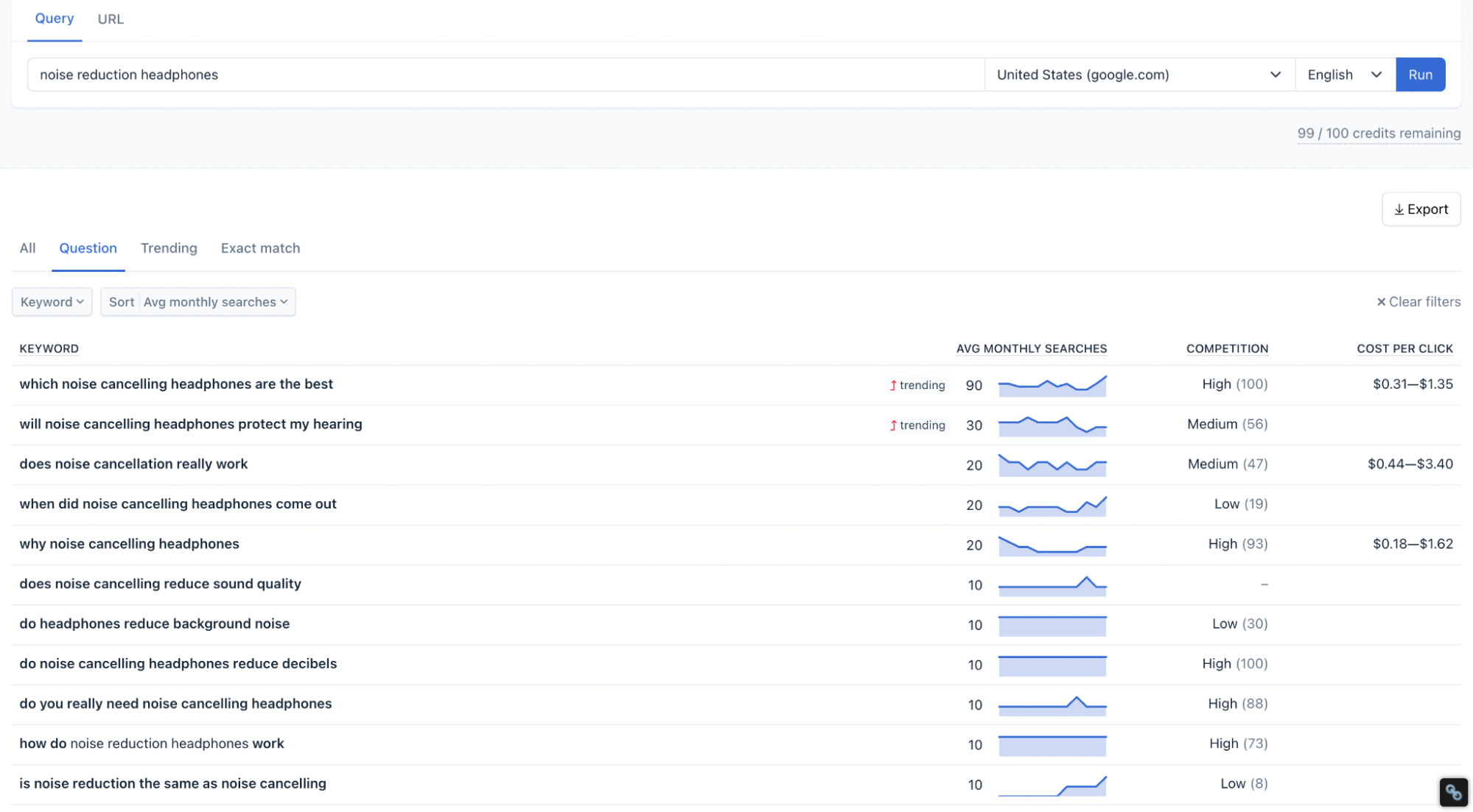
A Topic Exploration search for "noise reduction headphones."
You can get ideas for other trends or topics and note them as you brainstorm.
Another free online tool you can use is Answer The Public.
Here’s an example of the keyword “gas grill” using the tool.
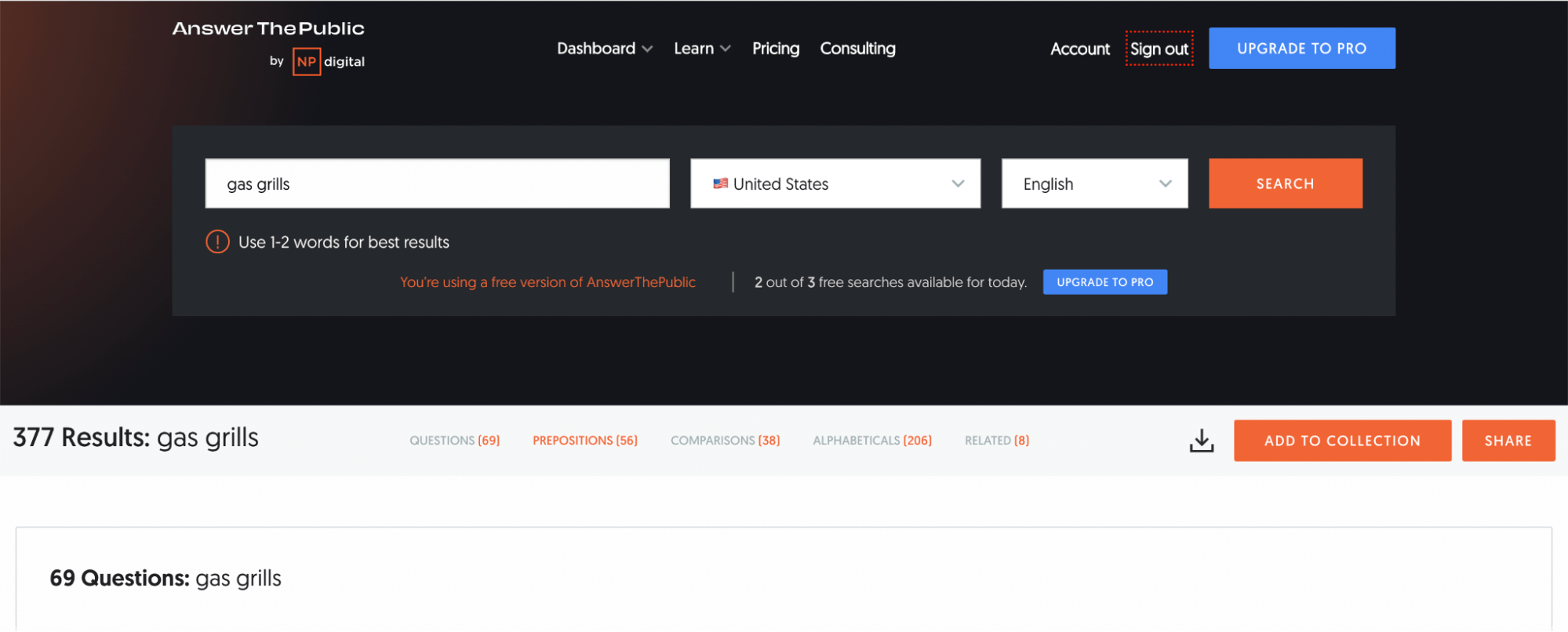
An Answer The Public search for "gas grills."
The tool will spit out topics like:
the taste when you use a gas grill
which gas grill is best
are gas grills safe
where to light a gas grill
Download all the keywords or topics on an excel sheet.
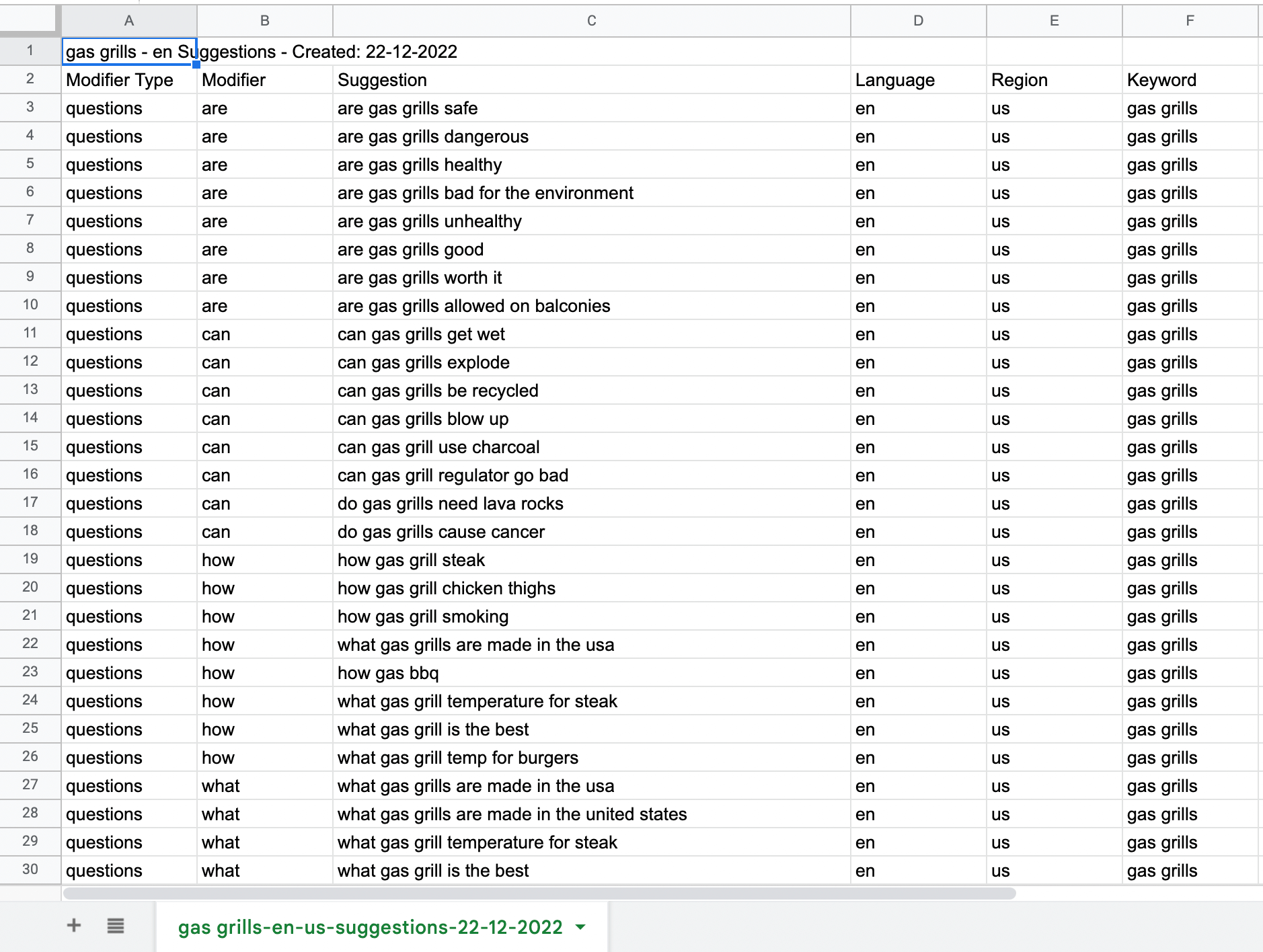
An export of the "gas grills" search in Answer the Public.
You could also use Google to create topic ideas.
If you run a Google search for “gas grill,” you’ll see featured snippets or a section called “People Also Ask.”
Google autogenerates this section based on its large database of searches. It can be beneficial for brainstorming topics.

People also ask section of a Google search for "gas grill."
If you click on a question, it will drop down more questions.
A neat little hack to automate this process is by using SEO Minion. SEO Minion can spit out these topics on a spreadsheet for you automatically.
Here’s how it works.
Load up SEO Minion and search your keyword. We’ll continue with the “gas grill” example here. You’ll set the drop-down menu to “8 levels”. This clicks and expands the questions 8 times. This will get a lot of questions or topics.
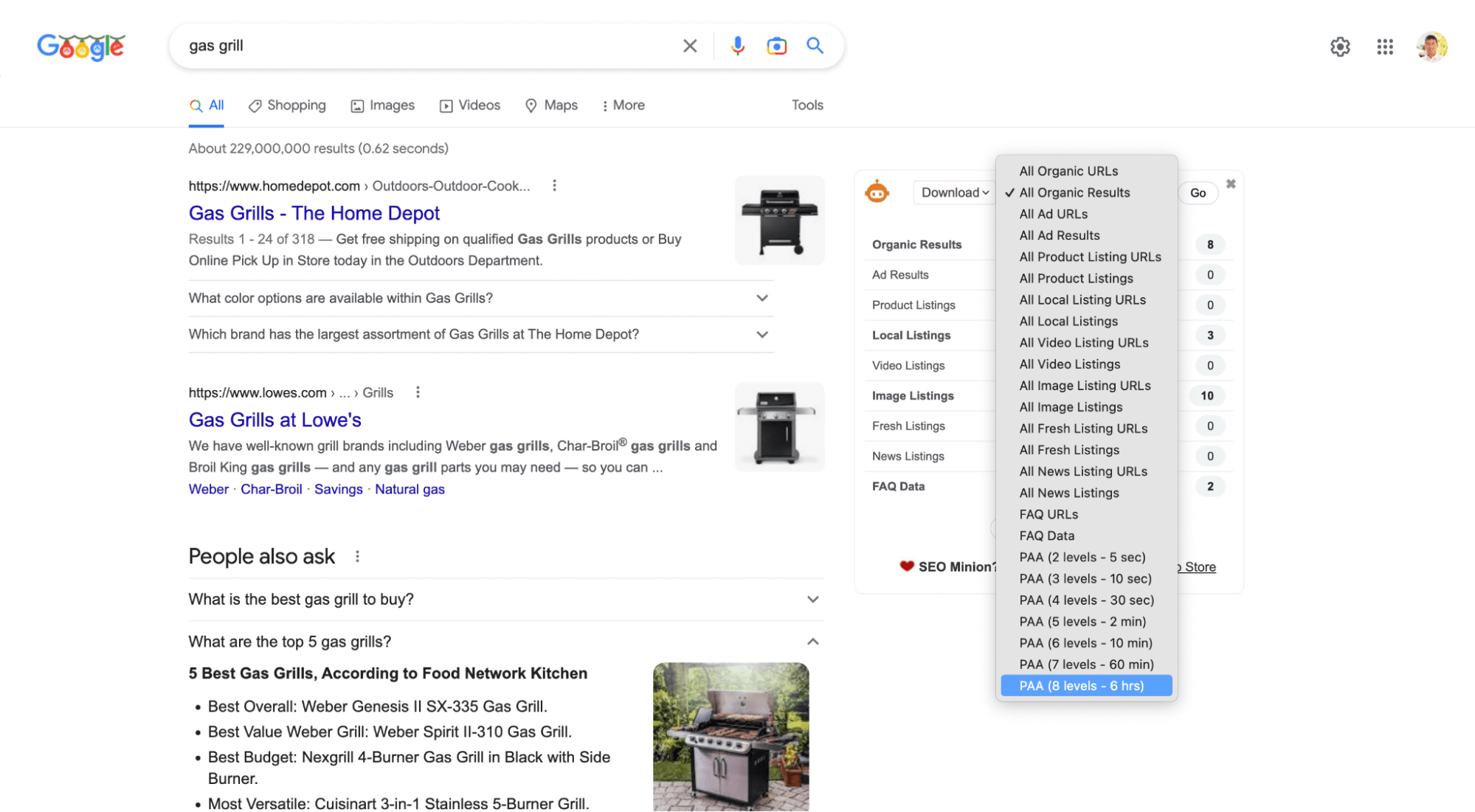
A Google search for "gas grill" with SEO Minion installed.
Building out topic clusters is very important for SEO. Top clusters are a group of interlinked web pages centered on big content known as pillar content.
Once you’ve used the tools above to find the different questions surrounding your niche, move on to keyword research.
Step 2: Do keyword research
Before you can start writing, you need to understand what your target audience is searching for. This is why keyword research is an essential part of SEO content writing.
This involves researching and analyzing keywords for their monthly volume, competitiveness, and business value.
Use SEO tools like Clearscope’s Topic Exploration tool, Ahrefs' Keyword Explorer, and Google’s Keyword Planner.
When starting an SEO campaign, begin by mapping out keywords for every stage of the marketing funnel; awareness, interest, consideration, and conversion.
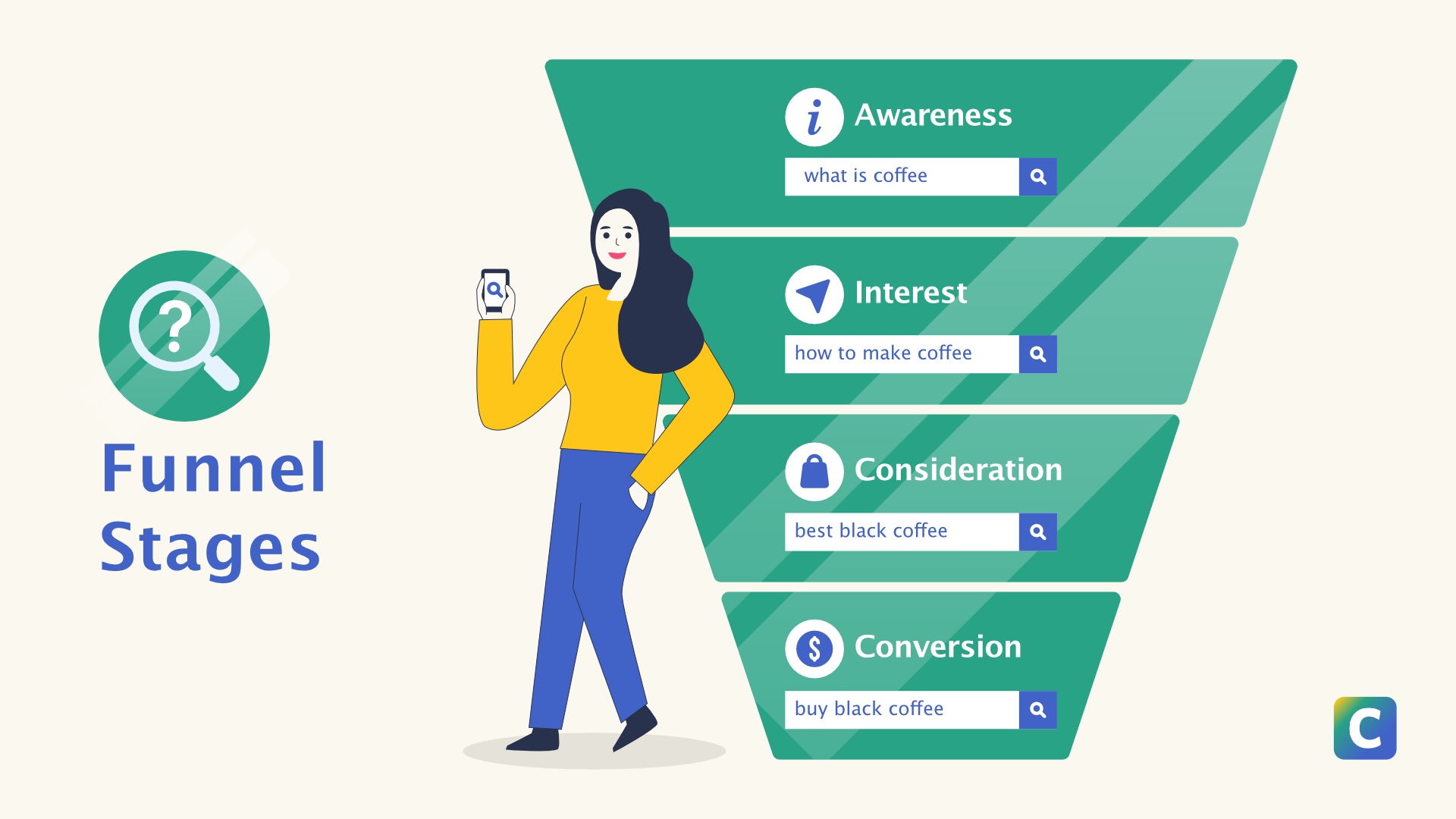
Funnel stages illustration.
Clearscope’s Topic Exploration Tool
If you are looking for a tool that matches search intent with a keyword, try Clearscope’s Topic Exploration tool.
We’ll review tips and tricks to find keywords to seed your content. Let’s say you are a software as a service (SAAS) company that delivers bulletproof coffee straight to people’s doorsteps.
Here’s an example of the topic “bulletproof coffee” in Clearscope.
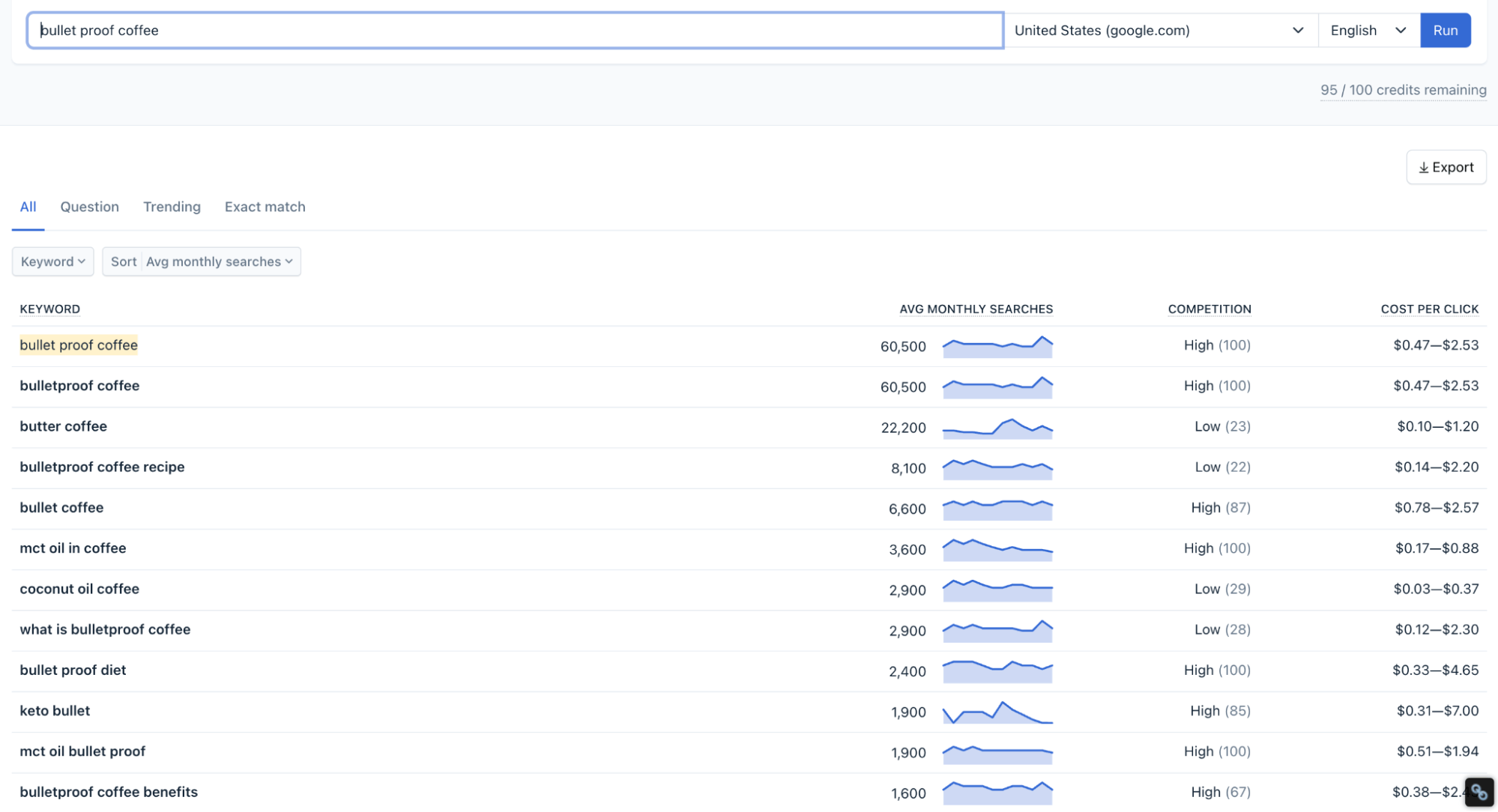
A Topic Exploration search for "bullet proof coffee."
In this stage, you are just organizing the different keywords before doing content creation.
Write down keywords based on where they are in the funnel, if it has nice business value, organic traffic potential, and appears easy to rank for based on their Keyword Difficulty (KD) score.
Keep an eye out for long-tail keywords. Although they get less search volume, they will typically have a higher conversion value as they are more specific.
Step 3: Analyze the search intent
After you perform keyword research, you’ll need to pair the keyword with a search intent.
For example, if a person is searching for a “business expense tracker template,” they intend to find a template to track their tax deductions or business expenses. If you write a piece of content about if you need to keep receipts for tax write-offs without a template, it will not rank on the first page of Google.
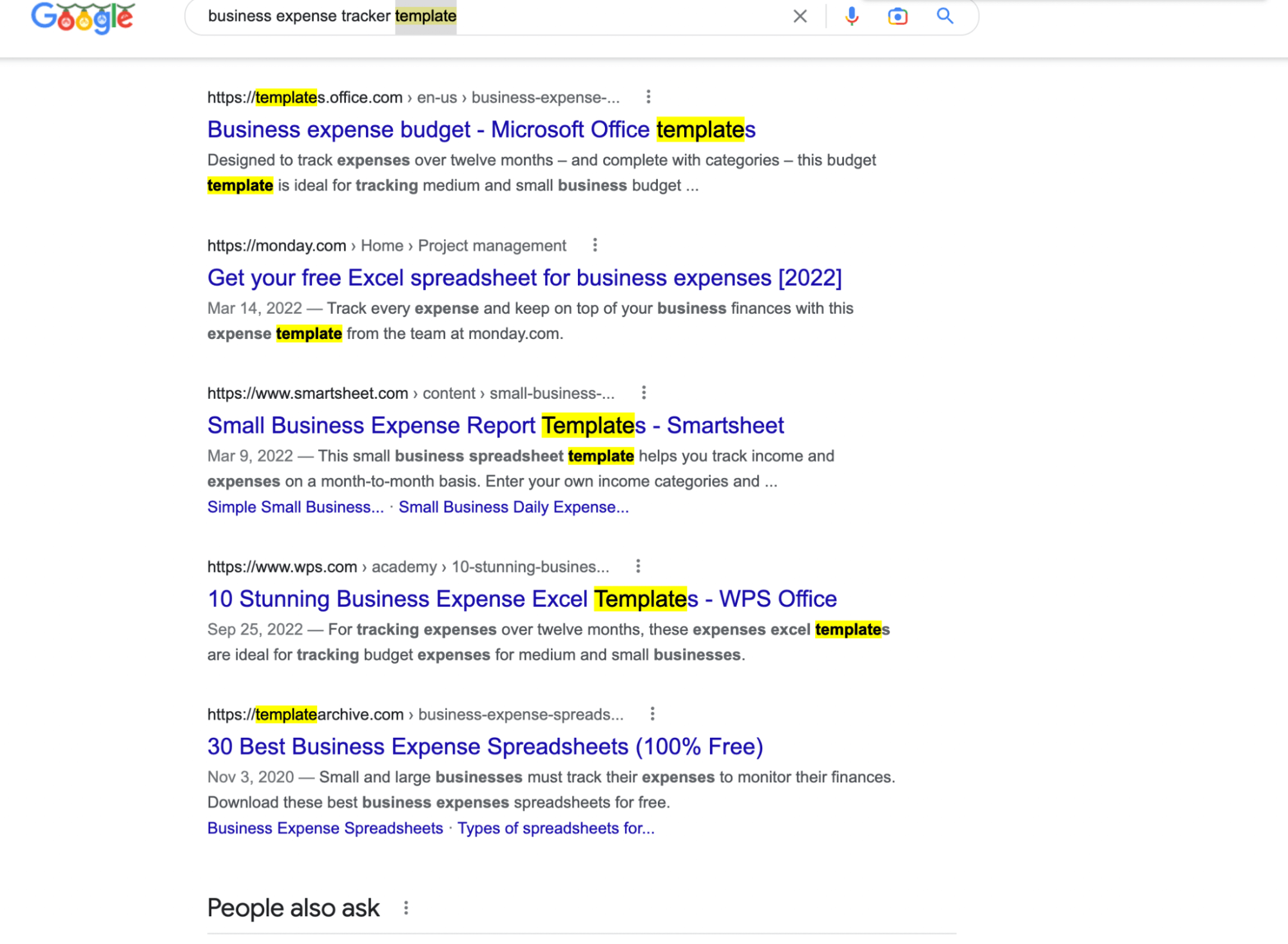
A Google search for "business expense tracker template."
You can create the most outstanding piece of content, but if it does not solve the search intent or the reason why a user is searching up a query, your visibility in the rankings will be very limited.
There are four types of search intents:
Informational: the user wants to gain more knowledge or information, i.e., how to do real estate
Navigational: the user wants to navigate to a specific website or page, i.e., eBay contact
Transactional: the user is trying to buy something at that moment, i.e., buy Apple computer
Commercial: the user is looking to buy or educate themselves to buy, i.e., Tesla reviews
At the core of it, SEO copywriting is all about solving the problems of a user’s search query in the best way possible. Match the keyword with a search intent, and then curate the best kind of content to help the reader solve their problem.
Read our complete in-depth guide on how to analyze search intent.
Step 4: Structure content
Once you've identified the most relevant target keyword for your content and uncovered the search intent, it's time to structure your SEO content. I’d recommend you create a content brief for each target keyword. A content brief is almost like a game plan for ranking specific keywords.
To analyze search intent behind keywords, you could analyze the first page of the SERPs.
Plug in a keyword into Google and observe the content’s format, type, idea, and angle.
Format: Are they guides, lists, recipes, instructions, free tools, how-to articles, etc.?
Type: Are they blog posts, landing pages, product pages, etc.?
Angle/idea: Is there a dominant idea or angle each page is about?
Observe the sub-topics and headers of all the pages.
Then use our free content brief to develop an SEO strategy around ranking for the keyword.
Header tags (H1, H2, etc.) help organize your content and signal to search engines the hierarchy of your content.
Use them appropriately to improve the readability of your content.
Clearscope’s tool also has a tab showing how all of your competitors outlined their content pieces. You can quickly see similar headings and topics your competing pages cover that you may want to cover in your piece.
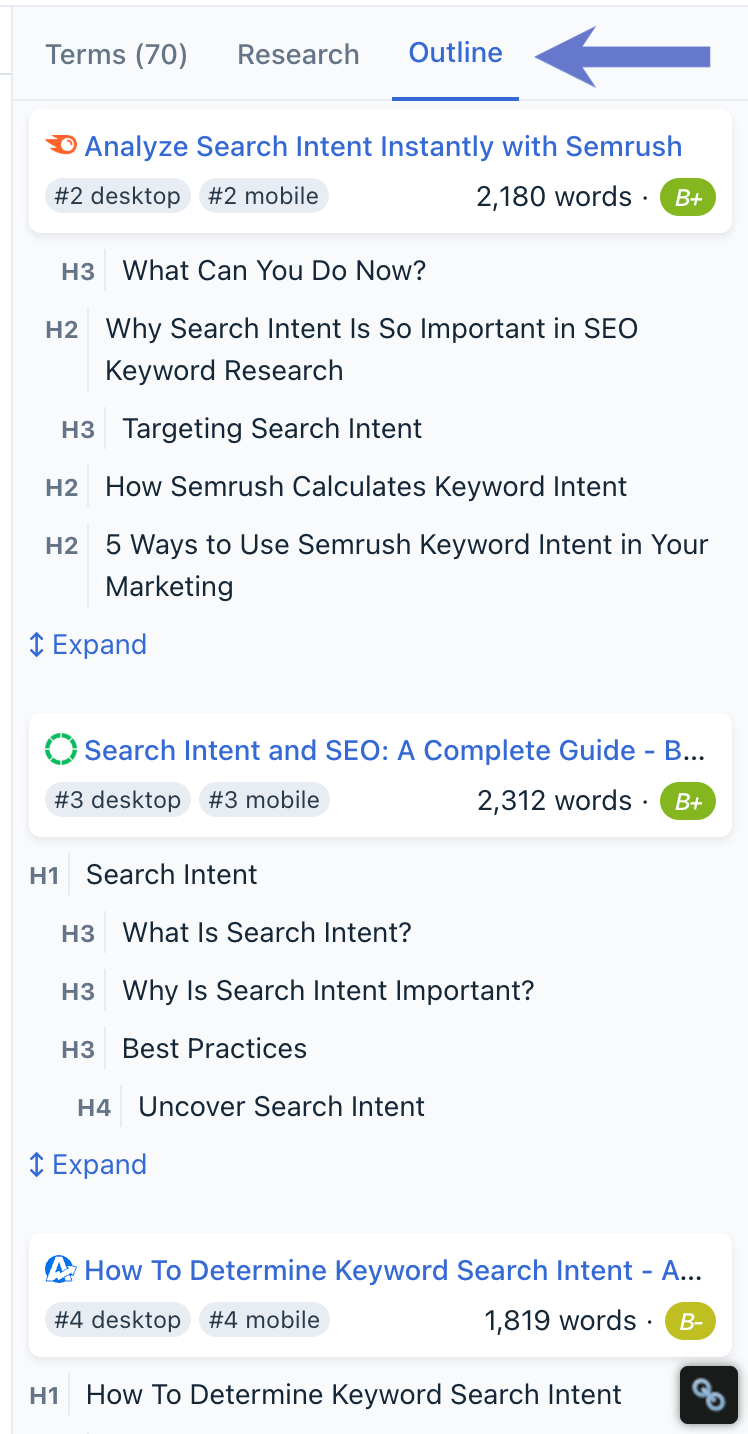
The Outline tab of a Clearscope Draft.
This will give you ideas of topically relevant headers and subheadings you could use in your article.
Step 5: Create content & optimize for the keyword
Once you have the structure or outline for what to cover to solve the intent behind the keyword, the next step is to create SEO-friendly content.
Google uses machine learning to reveal the structure and meaning of the text. Google’s Natural Language Processing (NLP) API identifies relationships between words, interprets search queries, and generates a SERP. It is why Google can understand the difference between Amazon, the e-commerce brand, and amazon, the forest.
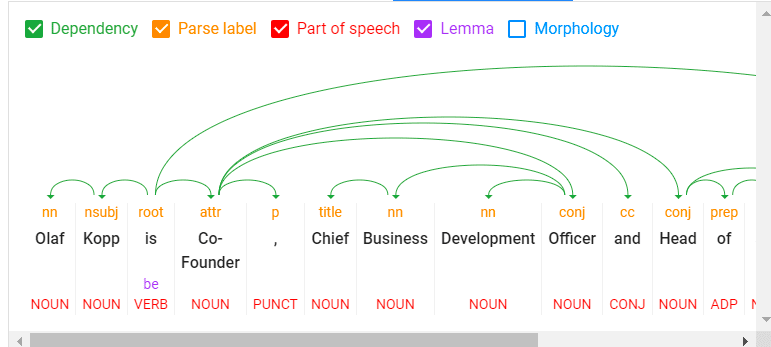
Since we know Google’s algorithm relies on semantic keywords or words that relate to each other conceptually to rank pages for search queries, we could use tools like Clearscope to feed the software the right related keywords. Using the right related keywords would inform Google what your page is about and if it satisfies the intent behind the query.
Creating SEO content with Clearscope
Clearscope is a state-of-the-art content optimization tool that provides robust natural language processing suggestions for a keyword. Here’s how it works. Clearscope looks at the top pages ranking on the SERP for the phrase and extracts the overlying themes, semantic keywords, and essential questions to answer/incorporate into your content.
We’ll do an example with the keyword: “how to build links”
Once you plug a keyword into Clearscope, you’ll receive a unique draft/document. The draft will tell you the recommended readability level of the content, word count, and content grade or score.

A Clearscope Draft for "how to build links."
Clearscope will give you a whole column of keyword suggestions the top-ranking articles all share along with their average keyword density or times the phrase is mentioned. The terms on the right are parts of the Google knowledge graph of semantically related words for your target keyword.
The ‘typical mentions’ recommendation helps you avoid keyword stuffing and involuntarily hurting your content.

The Terms tab in a Clearscope Draft.
As you write the content, the grade score will go up, and you’ll know how well you covered the topic for the inputted keyword.
A quick note: Clearscope is a tool to assist you in creating content that sends the correct semantics signals to Google that your piece solves the intent behind the keyword. Just because you wrote an article with a “high content grade” does NOT mean it will automatically rank high. You still need to solve the search intent behind the query, cover the suitable topics, and be helpful to the reader.
If you include semantically related terms, Google will have confidence your content will be good.
Clearscope shows you examples of ways your competitors use the phrase when you click a term.
You could use this to include more terms in the content and spot any holes or topics you missed.
Clearscope lets you share document/draft links without passwords so you can send them to any content writer.

Shareable link for a Clearscope draft.
Recommended reading: On-Page Optimization Tools to Create & Update Site Content
Add media to your content
You’ll want to add valuable media to enhance your pages. Relevant, helpful videos and images increase engagement and help your pages rank higher.
Users would stay on your page longer as people engage with your videos or images on your site. Check the results on the first page of Google to get ideas of how much media your competing pages used to complement their content. Sometimes if you type in a keyword, Google will serve up videos in the results.
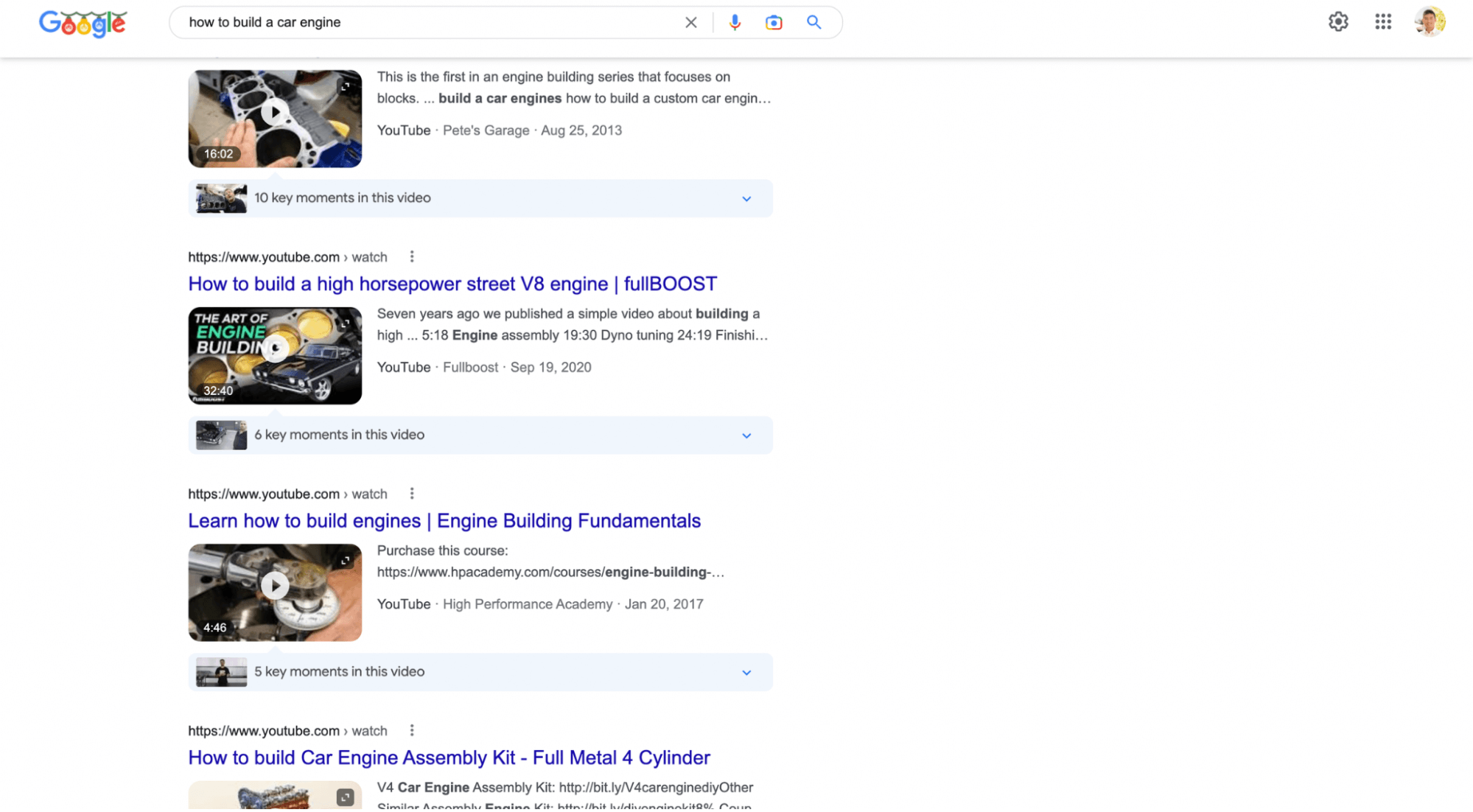
A Google search for "how to build a car engine."
If most pages on the SERP have videos in the content, you should probably add videos. If 99% is text only, you don’t need to create or add a video.
Use descriptive, keyword-rich file names for your images and include alt text to give search engines more context about the content of your images.
Add links to your content
Regarding on-page SEO, external linking to other relevant, high-quality sources helps demonstrate the authority and credibility of your content. Internal linking helps improve the user experience and can increase the time someone spends on your site.
Including both types of links is key for ranking on Google.
You’ll want to interlink your topic clusters or silos together to improve your pages’ relevance in Google’s eyes. Here’s a visual representation.
SEO title + meta Descriptions
Write in your page’s SEO titles and meta descriptions for each page. Both SEO titles and meta descriptions are essential for SEO because they help search engines understand the content of a webpage and determine its relevance to a user's search query.
SEO titles and meta descriptions are often displayed in SERPs and are meant to give users a brief overview of the page and why it's relevant to their search query.
SEO titles, also known as page titles or title tags, are the text that appears in the browser tab or on the SERP as the main headline for a webpage. They should be concise and accurately reflect the content of the page.
Meta descriptions are summaries of the content of a webpage that appears below the SEO title on the SERP. They should also be concise and accurately describe the page's content and may include a call to action to boost the click-through rate.
How do you write high-quality SEO content?
The content on the first page is there because it meets the user's needs or what they are searching for. The ultimate indicator of how well your content performs is how well it's concluding the search journey.
To ensure your content ranks and stays at the top of Google, your content needs to remain relevant, engaging, and valuable to the user.
We’ll go over some final tips for writing high-quality SEO content.
Originality and specificity
Content that is original and specific is content that Google loves.
Original content is more likely to attract and engage your audience because it offers something new and unique. It also sets your website apart from competitors and can help establish your brand as a thought leader in your industry. In addition, search engines tend to favor original content because it is more likely to be high-quality and informative.
In short, you need to write something useful for searchers. You can do that by interviewing experts in an industry.
Experts have a wealth of knowledge and experience that can provide unique perspectives and insights on a particular topic.
By interviewing experts in a specific field, you can add credibility and authority to your content. This can help establish your website as a trusted source of information and make it more likely that your content will be shared and receive backlinks from others.
Why content refreshes are important
Content refreshes are essential for SEO because they can help improve the overall quality and relevance of a website's content.
As time goes on, the information on a website can become outdated, or the search intent behind a keyword could change. Refreshing content can help ensure that the information on a website is current and accurate.
Outdated or irrelevant content can turn off users, leading to a high bounce rate and low engagement. Refreshing content can help improve the user experience by providing new information.
Content refreshes are essential for SEO because they can help improve the quality and relevance of a website's content, leading to better search engine rankings.
It’s time to create content that Google loves!
Writing content that ranks on Google involves understanding your audience and helping them in the best way possible.
By choosing targeted, relevant keywords, creating easy-to-read content, using header tags appropriately, including internal/ external links, optimizing images, and satisfying the search intent behind the keyword, you can create SEO-friendly content that is more likely to rank well in search results.
Follow these tips, and you can help improve the visibility and credibility of your website on Google.
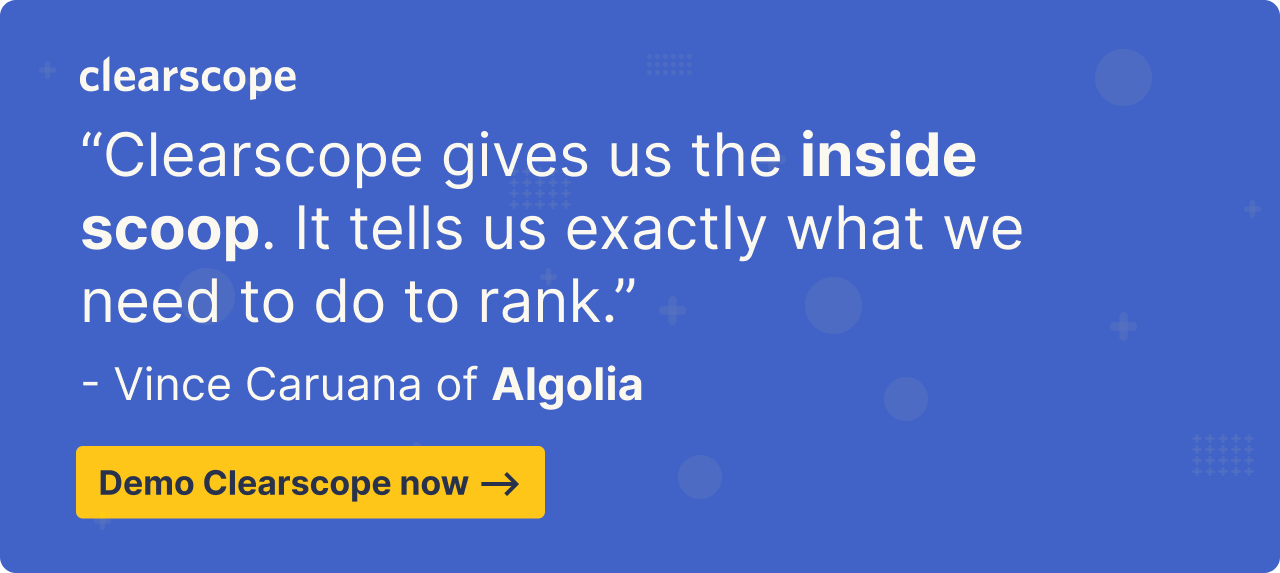
Topic Clusters: What Are They? Do They Help Your SEO? (with Video)
Learn how to implement a topic cluster strategy with our step-by-step guide plus a video.
Read more10 Essential SEO Content Optimization Tips for Marketers in 2023 and Beyond
Read our guide and discover ten SEO content optimization best practices to improve search engine visibility and drive more organic traffic to your website.
Read more7 On-Page Optimization Tools to Create & Update Site Content
Our guide compares the best on-page optimization tools to research keywords, write SEO-optimized content, and improve rankings in Google search results.
Read more